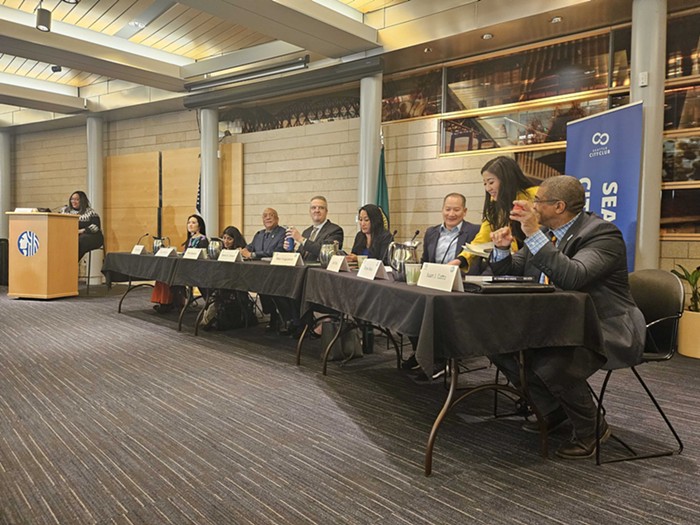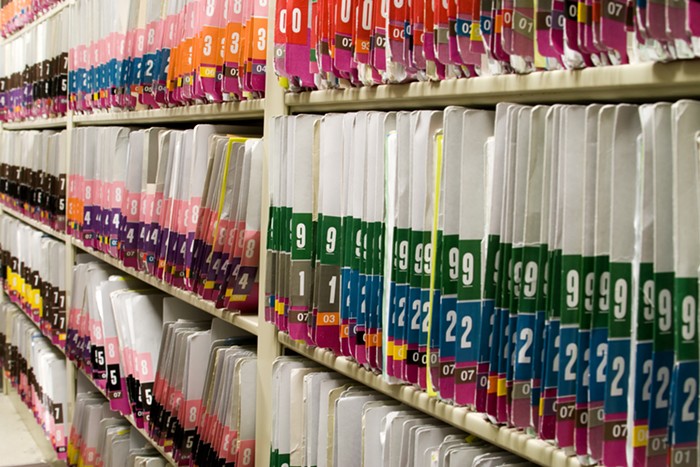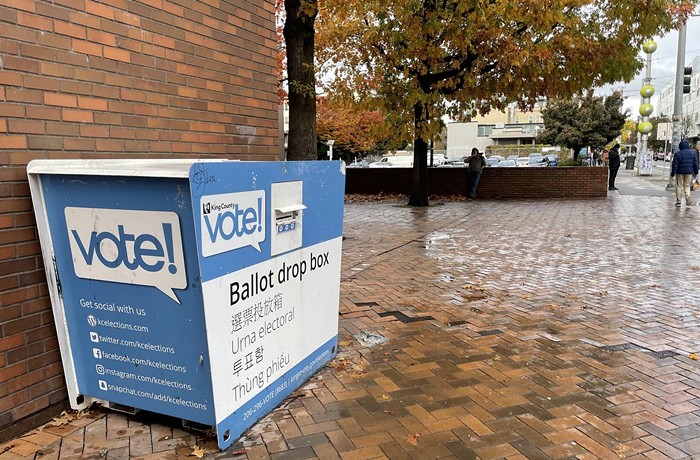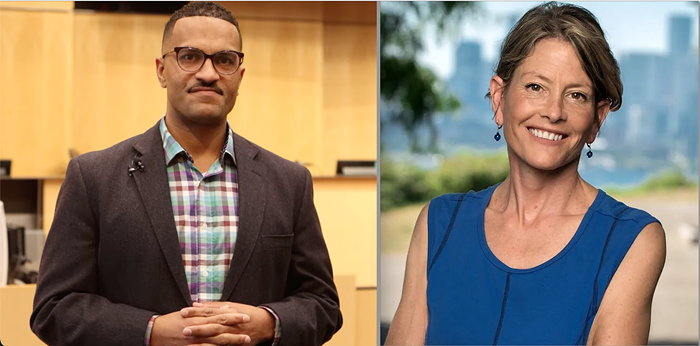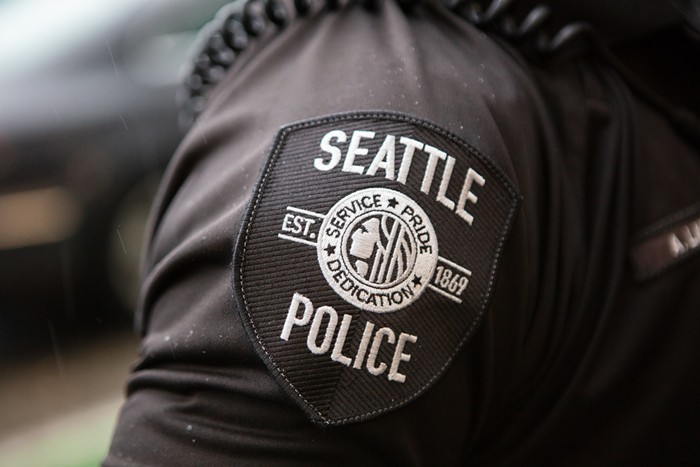A specter is haunting Seattle—the specter of a War on Cars. All the powers of Old Seattle have entered into a "holy" alliance to win this war: Seattle Times publisher and city council president, columnist Joni Balter and developer Kemper Freeman, Rainier Club regulars and suburban slobs.
Where is the advocate for increased bike and pedestrian safety who has not been branded an anti-car "militant"? Where is the politico who has not used the "War on Cars" rubric as a tool for demonizing the nondriving classes, for marginalizing our city's walkers, bike riders, and mass transit users?
The mindless repetition of this "War on Cars" falsehood—by car advocates harboring a phony, self-serving sense of victimhood—has led to a situation in which this "War on Cars" is acknowledged by most Seattleites to be real. Because of this regrettable specter, it is high time that cyclists, pedestrians, and their transit-riding comrades openly publish their views, their aims, their tendencies, and meet this nursery tale of a "War on Cars" with a manifesto of and by the nondrivers themselves:
I. The car-driving class must pay its own way!
For cars we have paved our forests, spanned our lakes, and burrowed under our cities. Yet drivers throw tantrums at the painting of a mere bicycle lane on the street. They balk at the mere suggestion of hiking a car-tab fee, raising the gas tax, or tolling to help pay for their insatiable demands, even as downtrodden transit riders have seen fares rise 80 percent over four years.
No more! We demand that car drivers pay their own way, bearing the full cost of the automobile-petroleum-industrial complex that has depleted our environment, strangled our cities, and drawn our nation into foreign wars. Reinstate the progressive motor vehicle excise tax, hike the gas tax, and toll every freeway, bridge, and neighborhood street until the true cost of driving lies as heavy and noxious as our smog-laden air. Our present system of hidden subsidies is the opiate of the car-driving masses; only when it is totally withdrawn will our road-building addiction finally be broken.
II. All power to the people's transit
If Seattle is to become a people's paradise, our buses, rail, streetcars, and ferries must stretch into every neighborhood, running reliably, affordably, and at all hours of the day and night. Since mass transit serves the masses, the mass of our transportation dollars must hereafter be spent to meet its needs.
III. The pedestrian and bicycle classes must be protected. And served!
The history of transportation is the history of struggle between the drivers and the nondrivers whose lives and limbs have literally been crushed. Between 2000 and 2009 in King County, 19 cyclists and 238 pedestrians lost their lives to cars, while injuries sent another 423 cyclists and 1,656 pedestrians to our hospital wards for two days or more after being hit by cars. If there is, in fact, a "War on Cars," then the cars are winning—as a look at recent headlines confirms. Saturday, September 10, brought the death of a young cyclist in the University District, and Sunday, September 11, brought the death of a woman biking on the Olympic Peninsula while wearing a helmet and a bright protective vest. Both were killed in collisions with cars.
The bikers and walkers, which neither slurp government dollars nor consume natural resources at the pace of the drivers, demand safer streets and sidewalks. As the Economist suggested on September 3 when responding to Seattle's spate of recent cyclist deaths, cars on streets with bike lanes must be subjected to "traffic calming" methods already used in European capitals like Amsterdam, Copenhagen, and Portland. When cars must slow down below 20 miles per hour, they kill less than 5 percent of collision victims. And the busiest bike lanes must be physically protected from the four-wheeled instruments of death through concrete buffers, rows of trees, or other barriers. In some places, whole streets—yes, whole streets, we have plenty to spare—must be closed to cars, creating bike and pedestrian malls and paths of the kind found throughout more forward-thinking, class-conscious cities.
We make these demands because, unfortunately, we must. Our epoch, the epoch of the car, possesses this distinct feature: It has created a simplified antagonism. Seattle as a whole is now more and more splitting up into two great hostile camps, into two great classes directly fighting each other—car driver and nondriver.
This antagonism traces directly to the creation of the modern car driver, a privileged individual who, as noted, is the beneficiary of a long course of subsidies, tax incentives, and wars for cheap oil. But the same subsidies that created this creature (who now rages about the roads while simultaneously screaming of being a victim in some war) can—and must, beginning now—be used to build bike lanes, sidewalks, light rail, and other benefits to the nondriving classes.

September 11: About three miles west of Port Angeles, a Mercury Sable driven by a 65-year-old woman struck a woman riding her bicycle along Highway 112, according to the Peninsula Daily News. The cyclist had been wearing a helmet "and a neon-yellow safety jacket" when she was hit from behind. She died from the injuries.
September 10: Robert Townsend, 23, was delivering a sandwich for Jimmy John's just after 6:00 p.m. Riding his bicycle south on University Way Northeast, he collided with a Hyundai Sonata that was coming from the opposite direction and turning left onto Northeast Campus Parkway. "As far as I could tell, the car's windshield was hit pretty hard and there was a terrible pool of blood in the middle of that intersection," says witness Tyler Brown.
Townsend soon died at Harborview Medical Center, according to the Seattle Police Department. The driver was not cited at the scene, and a final determination of fault could take months. "For us, this is as serious as a murder," says SPD sergeant Sean Whitcomb. "About the same amount of care and detail goes into this type of investigation."
But the cyclist likely had right-of-way southbound on University Way Northeast. There are no green arrow lights that would give the Hyundai driver a free left turn onto Campus Parkway. Whitcomb confirms what most road users already know: "When two vehicles going the opposite direction have a green light, typically the one that is making a turn must yield to oncoming traffic."
Pete Marino, the Illinois-based spokesman for Jimmy John's, says the company requires its delivery riders in Washington State to wear helmets—and, Marino added, "Robert was wearing one at the time of the accident."
July 28: Mike Wang, 44, was riding in the northbound bicycle lane on Dexter Avenue North in the late afternoon when an SUV struck Wang, killing him. The driver then fled the scene. Wang was wearing a helmet at the time.
July 22: John Przychodzen, 49, was wearing a helmet and riding on the shoulder of Northeast Juanita Drive traveling to his brother's house for dinner in Kirkland when a truck struck and fatally wounded him.
Chris Davis, an attorney who specializes in representing cyclists and pedestrians hit by cars, says the number of those cases coming to him "has been increasing steadily over the last couple years." Typically, he's had one dozen to two dozen of each type of case annually. But recently his number of such cases climbed by 20 to 30 percent.
Why more cases?
In part, Davis credits more cyclists on the road—including some who "ignore laws." Also out there, Davis adds, are more "ignorant motorists to endanger cyclists." Yes, confrontational cyclists can contribute to the problem, Davis says, but he thinks that overall "anti-cyclist sentiment" is the major factor in the increase in cases he's seeing.
"Motorists will become frustrated and crowd bicyclists and not give them enough room, come up on the bicyclists fast and out of frustration," he says. "The frustration translates into actions, sometimes intentional acts against the cyclist."
Davis's experiences—more injuries, more clients—appear to be borne out by citywide data that shows more collisions.
According to the Seattle Department of Transportation's 2007 bicycle and pedestrian collision report (which appears to be the most recent such report produced by the city), the number of collisions between bicycles and vehicles showed an uptick over six years. While there was an average of about 275 collisions per year from 2002 to 2005, that number rose to an average of 349 per year in the next two years (roughly a 25 percent increase). The following years were also up, according to separate data reported last month by the Seattle Times. The newspaper reported an average of 328 collisions per year from 2008 to 2010.
Fatalities from bicycle and car collisions have also risen: The city report shows only two fatalities in the four-year span from 2002 to 2005 (half a fatality a year on average, as macabre as that may sound). But over the next five years, according to the city's and Seattle Times' reports, bicycle collisions resulted in 10 fatalities. That is, on average, four times as many fatalities a year. And that average is borne out again this year, where as of last Saturday, two cyclists had been fatally hit in Seattle.
At the same time cyclist collisions and deaths have risen, the anti-bicycle rhetoric has grown more divisive and violent. Who is behind it? Consider the words of Michael Cornell, chair of the Green Lake Community Council.
"Bicyclists are militant and looking to cause a conflict whenever they can," he said at the group's community meeting on January 12 in the company of Seattle City Council member Tom Rasmussen. Seattle spends volumes more on car infrastructure than on bicycles or pedestrians, yet Cornell has complained of the "radical agenda against cars," saying, "I call it the war on cars and the people who need them," and describing the pro-bicycle agenda as a "war waged on people who drive cars."
So cyclists are all militant.
They're seeking out conflict.
They're specifically waging war on drivers.
And... now there's an uptick in drivers killing them.
Go figure.
But Cornell is hardly alone in ramping up the anti-bicycle-rider rhetoric.
Seattle Times columnist Joni Balter is equally divisive, if not as inflammatory. "Increasingly, cars are being shoved aside," Balter wrote in a recent editorial, "as evidenced by efforts to jack up commercial parking rates, the constant plea for more light rail, and significant transfer of asphalt to bike lanes." Shorter Balter: Funding non-car infrastructure is an attack on drivers... the same illogic some Christians use to claim same-sex marriage erodes the traditional penis-in-vagina kind. According to the US Department of Transportation, the number of passenger vehicles on the roads has increased by four million since the 1960s, yet always the victim, Balter bleats as if cars are an endangered species.
In a cavalcade of logical fallacies, Balter uses the Seattle Times as a platform to instigate more anti-bicycle sentiment. For instance: "Every new bike lane can make a road less appealing to a car or a truck. Bicycles prevail, freight mobility takes a sorry hike" (false dilemma). Also: "Bike and pedestrian lobbies, whose efforts began before the arrival of [Mayor Mike] McGinn, are already getting improvements that infuriate some motorists" (association fallacy). She asks "whether this group of citizens can impose their will on the rest of the place" (argumentum ad populum).
Cars are being forced off the roads, Balter insists (falsely), and oooh, it just makes her so angry! And she's hardly alone.
Portland radio host PK on Jammin' 95.5 pushed the pedal to the metal in 2006, announcing: "If you are a cyclist, you should know I exist, that I don't care about you. That I don't care about your life," the blog Bikeportland.org reported (the station never released an archive). "When I hear on TV that a cyclist has been hit and killed by a car, I laugh, I think it's funny."
While some people foment anti-cyclist rage, others are content to merely blockade spending on transit infrastructure. Seattle's prime non-mover-and-shaker is city council president Richard Conlin, who twice in 2010 voted to suspend the city's Transit Master Plan, thereby delaying rail planning. Conlin was also the city's chief advocate for a $4.2 billion deep-bore tunnel that lacks transit, and was for years a leading voice to stop the monorail project. And last year, Conlin advocated advancing construction on the new, wider 520 bridge in an effort to head off transit advocates from tweaking the design to accommodate light rail.
His pro-roads/anti-transit agenda lumps Conlin in with some rather unsavory company: the right-wing think tank Washington Policy Center, which has claimed that "Seattle's war on cars is a war on drivers"; Fox News, which relentlessly drums up the "Seattle's War on Cars" meme; and wingnut local blogger Stefan Sharkansky, who takes aim at Mayor McGinn for "punishing people for driving."
All the sort of violent rhetoric that can't help but have a violent end.

If money is ammunition in the war on cars, then cars have most of the firepower. The pie chart above cites the city's spending on various transportation projects. Only $18.4 million—about 7 percent—of the Seattle Department of Transportation's $270 million in expenditures last year was dedicated strictly to bicycle and pedestrian improvements. Another 6 percent, approximately, goes to transit, such as paying for buses in the downtown ride-free zone. But the vast majority of the city's transportation dollars—more than 85 percent—is dedicated to projects that solely fund vehicle infrastructure (such as parking programs) or primarily fund vehicle infrastructure (such as the Spokane Street viaduct and other major road construction). While the latter may include some pedestrian or bicycle amenities, the projects primarily serve cars. "It is false to argue that there is a war on cars," says SDOT spokesman Rick Sheridan. "When you consider the spending on road building, maintenance, traffic signs, and signals, we spend a significant percentage of our budget on vehicles."
Wallingford resident Doug stepped outside his home on August 26 to discover that city transportation workers had painted a giant bicycle on his street. "I now live on a giant bike path," he said. "We are winning the War on Cars!"
Indeed, between 2000 and 2009, car use declined in Seattle by 7.7 percent, according to the American Community Survey. During this same period, transit use increased 10.9 percent, biking increased an astounding 59 percent, and walking increased 4.4 percent. US Census data shows that in 2009, nearly 40 percent of Seattle's population walked, biked, bused, or carpooled to work. That number is only going to increase as the city becomes easier to navigate without a car.
For instance, voters approved a funding package in 2008 to extend light rail north to Northgate and east to Redmond. Two years prior, Seattle voters passed the nine-year, $365 million Bridging the Gap levy, applying a parking-lot tax that funds transportation maintenance and improvements. Since then, the Seattle Department of Transportation (SDOT) has added roughly 180 miles of bike lanes to city streets and a series of green "bike boxes" that give cyclists right-of-way at signaled intersections. In 2009 alone, SDOT added 26 blocks of new sidewalk to city streets, 40 new "countdown" crosswalk signals, and repainted more than 800 crosswalks. In the last few years, several road diets have eliminated vehicle lanes and replaced them with bicycle thoroughfares on 125th Avenue Northeast, Stone Way North, and other streets around the city—despite the protests of petulant neighbors who bray as if their freedom were under siege. Meanwhile, a First Hill streetcar connecting the International District to Capitol Hill is set to begin its circuit in 2013.
All the while, gas prices are rising and parking rates costs are increasing. The carless commuters see victory on the horizon.
Our heroes are fueled not by petrol, but by the inspiration from King County Council member Larry Phillips, who pushed past a phalanx of suburban Republican lawmakers to approve a $20 car tab fee this summer that will save commuters from a 17 percent cut in bus service. To put that victory in perspective, consider this: Metro's average monthly ridership is up 3 percent from 2010. (In May alone, the number of weekday bus and van trips exceeded predictions by 22,115.) "The best thing King County can do to recover the local economy is to keep buses on the streets so that people can get to work," Phillips says.
He isn't our only trailblazer—Wallingford resident Cathy Tuttle is head of the group Spokespeople. She's leading Seattle's "greenway movement" to convert select nonarterial roads that connect neighborhoods into dedicated bike routes, where driving is discouraged. In 2009, Tuttle wrote a grant asking the city to turn 44th Street, between I-5 and Stone Way North, into a greenway. Her grant was awarded last year and Seattle's first greenway will be open to riders by the end of November. Now at least five other groups in the city are organizing to build greenways in their neighborhoods.
Others can't be left out: Seattle City Council member Nick Licata is a tireless advocate for the city's Bicycle and Pedestrian Master Plans, which call for adding new sidewalks, crosswalks, and over 450 miles of new bike lanes to city streets by 2017; Representative Jamie Pedersen (D-43) pushed through a vulnerable roadway users bill this year that imposes up to a $5,000 fine and 90-day license suspension on drivers who kill other road users. And it goes without saying that behind all this is the invisible hand of the Cascade Bicycle Club.
But perhaps our greatest mmm-asscot is Seattle City Council member Mike O'Brien's perky ass, honed from 10 miles of bicycle commuting every day (O'Brien's ass has only bused to work three days since taking office in January 2010). One of O'Brien's goals is creating a dedicated bike route, like a cycle track, in downtown Seattle. "I don't know what street makes the most sense," he says, "but right now, it's a little scary downtown. There's a huge gap for new riders between what's possible and what we have today."
Keep your quarter; O'Brien's ass is so tight you could bounce a brick off it. ![]()


